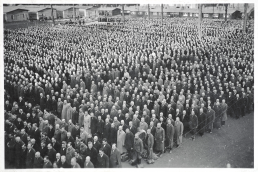1938: Deported to Buchenwald as “special operation Jews”
In the course of the November pogroms of 1938, the Gestapo sent 30,000 Jews, designated by the SS as “special operation Jews,” to concentration camps. Some of the nearly 10,000 men deported to Buchenwald were teenagers.
The camp was ill-prepared to receive 10,000 new prisoners. The Jewish prisoners were placed in improvised housing, and were subjected to humiliation, harassment and violence. Several prisoners were murdered by the SS or died as a result of prison conditions. Most of the survivors, including almost all of the young people, were released after a few weeks. The goal of the Nazi regime was still to convince German Jews to emigrate by using violence and terror.
Onlookers in front of the burning synagogue in Gottschedstraße in Leipzig, 10 November 1938.
In November 1938, the National Socialists burned down synagogues throughout the German Reich. They invaded the homes and businesses of Jews and mistreated the residents. In many cases, a mob of onlookers gathered in front of the synagogues.
The excuse for the pogroms was the attack by a German-Polish Jew on a German diplomat in Paris. The state-organized terror marked the transition from the rejection and exclusion of Jews to their systematic and violent persecution.
(Sächsisches Staatsarchiv)
"So I came to school with my bicycle and wanted to put it in the cellar. And someone came to meet me and said, 'There's no school today, the synagogues are burning.' And then I rode off on my bicycle to Gottschedstraße. And there I saw the big synagogue burning. A few hundred meters further, the big Orthodox synagogue [...] Then I rode through the city. And there I saw all kinds of Jewish stores, where the shards of glass lay on the sidewalk, where the goods had been torn out of the shop windows. On Augustusplatz I saw the large clothing store Bamberger & Herz burning. It was terrible. The whole city was full of glass shards. At Brühl too, for example. Brühl was famous for its international fur trade, which was very much in Jewish hands. And there too very much was ruined and very much was broken by the SA."
"Today there’s no school, the synagogues are burning." Recollection by Rolf Kralovitz of the November 1938 pogrom in Leipzig, interview from 2008.
(Buchenwald Memorial)
Document issued by the Frankfurt (Main) police department concerning the fate of the Berberich family, 3 June 1950.
According to the document, Sally and Edith Berberich emigrated with their son Hans to Cochabamba in Bolivia. Even in this postwar document, the names Israel and Sara remain added to their actual names, a convention forced upon the Jews by the Nazis in 1938.
The November pogroms of 1938 triggered a wave of emigration. Between then and the beginning of the war, about 120,000 Jews left the German Reich. They had to leave their property behind.
(Arolsen Archives)
Children in the Buchenwald Concentration Camp
Aktion Arbeitsscheu Reich 1938
In 1938, the number of prisoners in the concentration camps doubled. As part of the Aktion Arbeitsscheu Reich (Operation Work-Shy Reich, two waves of arrests of purported “anti-social…
Rescue Initiatives: Bricklayers’ school and Poles’ school
Under the pretext of training skilled workers for the German war effort, prisoner functionaries around Robert Siewert, a political prisoner and Kapo of the construction detail
Limited shelter: The children’s blocks 8 and 66
Children were particularly vulnerable to the dangers of the camp. To protect them, political prisoner functionaries set up a children's block in Block 8 of the main camp in July 1943.
Deterrence through forced labor: Disciplinary work prisoners
From 1941 to 1944, a Gestapo labor re-education camp existed at the Buchenwald Concentration Camp.









